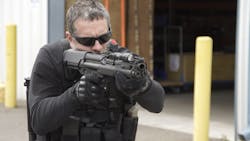The Need For Shotguns In Law Enforcement
Firearms-related fatalities have been the leading cause of officer deaths in 2018, according to preliminary data from the National Law Enforcement Officers Memorial Fund (as of June 30, 2018). Officers need to be equipped to respond to multiple firearms threats. Shotguns, specifically, are a force multiplier in many instances, provide a less lethal option, and are versatile, as well as easy to use and generally easy to repair.
The need for more than a handgun
It’s easy to look at events over the last two decades and realize the need for law enforcement to carry higher-firepower weapons. LEOs are typically the first responders to scenes, from accidents to public crowd control issues and more; although not all of these scenes will require a shotgun or a weapon, there’s a very good chance that the responding officer will be outnumbered and out-manned, says Ryan Williams, design engineer (R&D), KelTec CNC Industries. “The pistol that officers are assigned is looked at as a secondary weapon; the primary weapon for defense is the rifle or shotgun that they are assigned as you will want to have more firepower than the threat you are responding to,” he says.
Rifles have a lot of great benefits for law enforcement for road patrol and tactical operations, as seen in many instances before, and more heavily since, the North Hollywood Bank of America robbery in 1997. They are tools that are designed to be effective and accurate at longer distances, however, they were never meant to replace the shotgun.
Shotguns fill a specific niche in law enforcement, typically deployed in scenarios where threats are encountered less than 25 yards or up to 50 yards. With proper ammunition, shotguns can even be effective up to 100 yards, which sets it apart from a rifle—the ability for different ammunition selection. From slugs for distance, to buckshot for close quarter/close range, to breaching rounds (typically less than 6 feet for breaching doors off hinges), this is more immediately useful for a patrol function than having a rifle, says Williams.
There’s also the intimidation factor with shotguns. A weapon like a shotgun that has a wide range of firepower can allow for that officer to have more of a “command presence” on scene and quickly take control. “There’s nothing quite like the sound of ‘racking’ the shotgun,” says Williams. “The metal sliding/action sound will disperse a rowdy crowd pretty quick from experience. You really can’t get this with a rifle.” Unlike rifles, shotguns also give law enforcement the option of using less lethal options, including beanbag or rubber bullets for crowd control. Don’t forget, the shotgun can also make a quick breaching tool with some modifications.
Simplicity and reliability
If your agency did away with or has forgotten about its shotguns, newer models available make it worth taking a second look. Agencies will want to look for a shotgun that is intuitively simple for training purposes, as well as at reliability and cost. Cost is one of the largest factors in purchasing, from the cost of the weapon to liability to training and ammunition. Other factors agencies should keep in mind include weight and capacity for this type of weapon. Typically, a shotgun will weigh about 7 to 8 pounds and have about 4 to 6 rounds of ammunition in the weapon depending on the manufacturer; however, some models available today have a shorter overall length than traditional shotguns, with a higher capacity.
Despite so much attention being placed on rifles and handguns, there’s still a place for the shotgun in the law enforcement toolbox.



